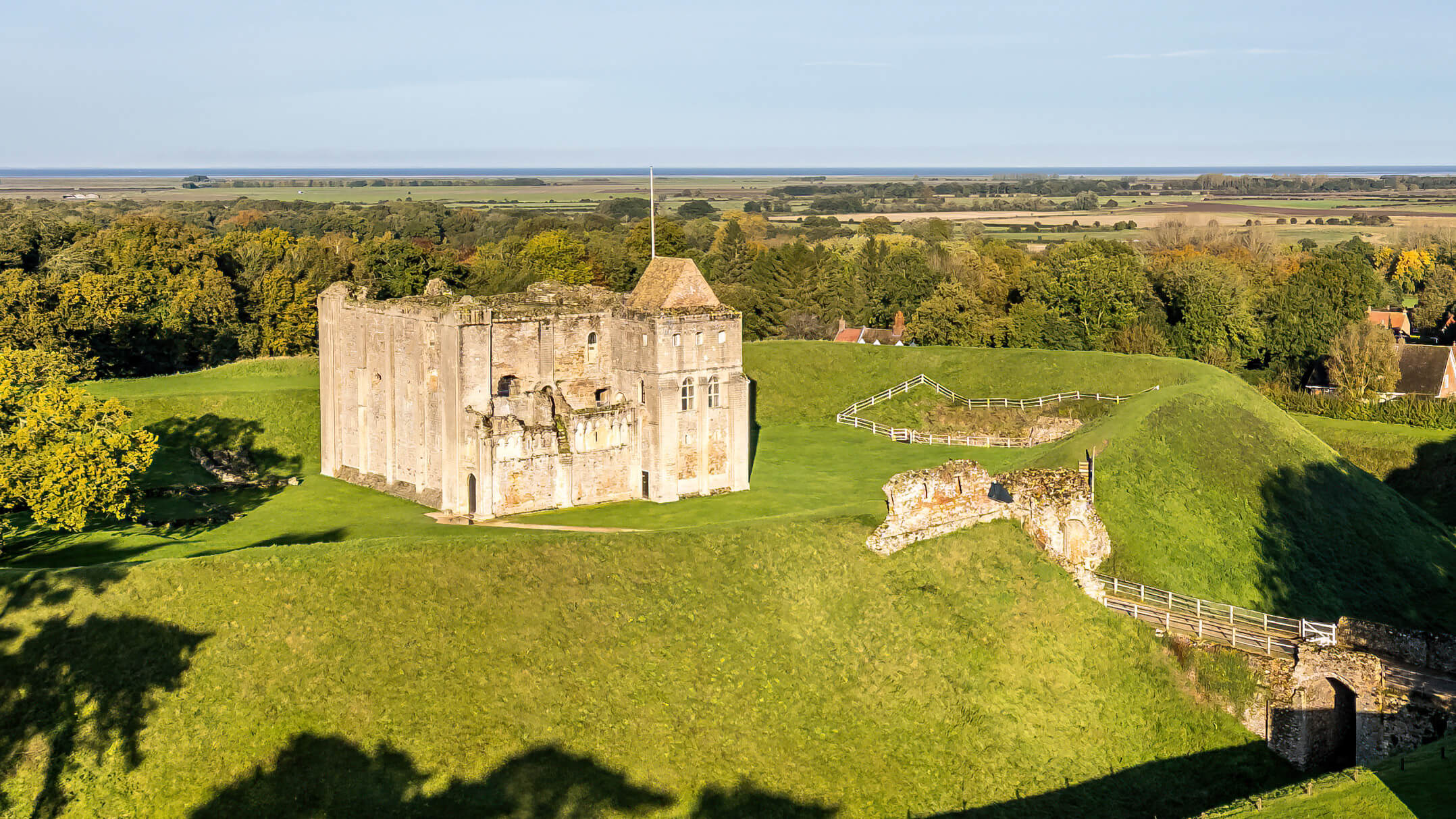With more than 20 castles around Norfolk, you have plenty of options to explore, but with limited time you may need to prioritise. In this post, you will find an overview of my favourite castles in Norfolk to help you decide and plan your visit(s).
Note: This post contains affiliate links. As an Amazon Associate, we earn from qualifying purchases. Please see disclosure for more information.
If you want to find out about more things to do in Norfolk, be sure to sign up for our weekly email newsletter here.
7 Best Castles in Norfolk to Visit
Norfolk’s castles are full of history and definitely worth visiting. Each one is unique with its own stories and look. Be sure to bring along your camera.
All the castles on this list are great places to take the kids. They will enjoy exploring the ruins and learning more about the history of the area. Also check out our list of things to do with kids in Norfolk for more family-friendly ideas.
Some of the castles in Norfolk are free to visit. Many are English Heritage sites that members can visit for free (get information about English Heritage membership here).
#1 Norwich Castle
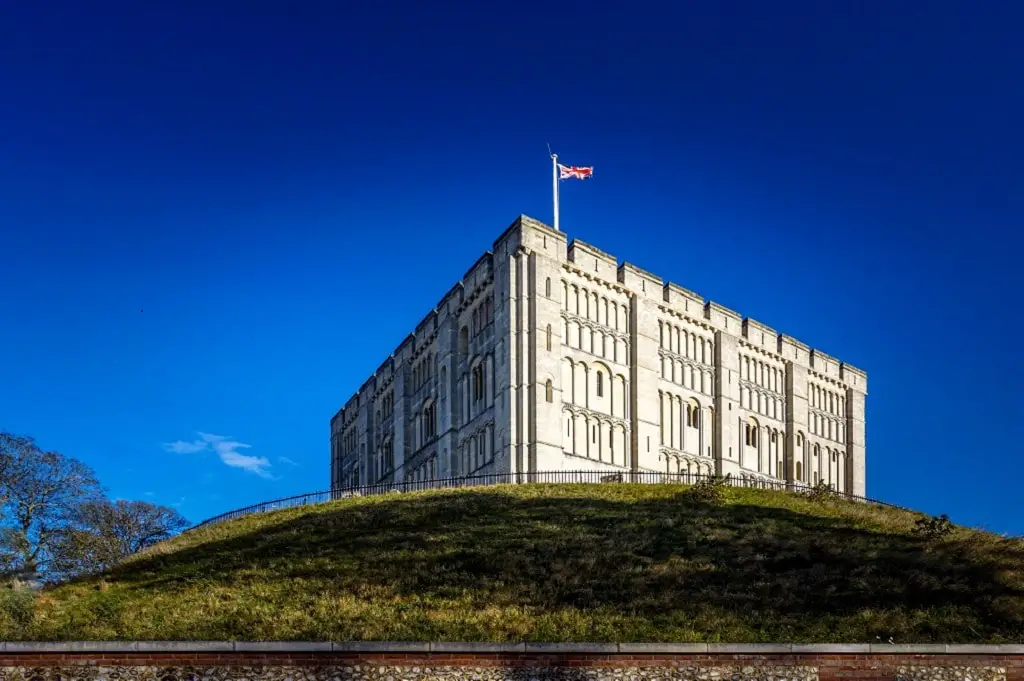
Norwich Castle is probably the best known of all the castles in Norfolk. The Scheduled Ancient Monument dates back to around 1067 and was founded by William the Conqueror. It is one of the top attractions in Norwich.
Note: Norwich Castle is currently undergoing a £13.5m project to transform the castle keep. The Norwich Castle: Royal Palace Reborn Project will cause some planned closures. The medieval Castle building and the Anglo Saxon and Viking galleries are currently closed, but most galleries are open, including Art, Decorative art, Natural History, Boudicca and the Romans and the Regimental Displays. Admission is accordingly reduced. Get more information here.
Before Henry II built Orford Castle in the mid-12th century, Norwich was the only major royal castle in East Anglia. The Grade I-listed building still towers over the city, but only the castle keep still stands and inside nothing remains of its medieval layout.
Over the course of its long history, Norwich Castle has been a gaol and sight for public hangings. It’s not surprising there have been several ghost sightings, as it’s one of the most haunted places in Norwich.
Since 1895, Norwich Castle has been a museum. Its interactive displays make it one of the best places to go in Norwich with kids. You can explore the castle, enjoy exhibitions about history and art, and tour the dungeon and the battlements.
They have a diverse collection of fine art, including costume, textiles, jewellery, glass, ceramics, teapots, and silverware. There are also displays about Boudica and the Romans, Anglo Saxons and Vikings, and Egyptians as well as a Natural History Gallery.
If you want to visit Norwich Castle, it’s best to book your tickets online in advance here. You may be able to purchase unsold tickets when you arrive but availability is not guaranteed.
Read more about visiting Norwich Castle here.
#2 Castle Rising
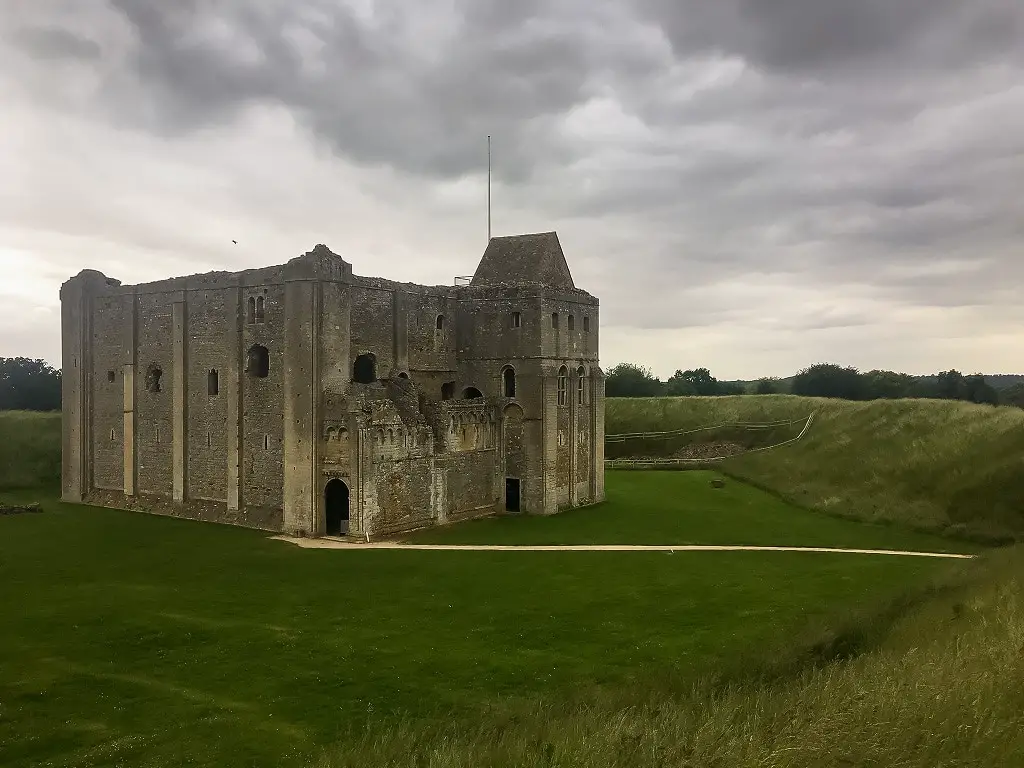
Castle Rising Castle is one of the most famous 12th-century castles in England because the stone keep is mostly intact and it is surrounded by 20 acres of massive earthworks. It is also considered one of the most haunted places in Norfolk because of Queen Isabella aka the She-Wolf of France, who once called Castle Rising home.
While the castle was built in the 12th century by the Norman lord William d’Albini for his new wife, the widow of Henry I, it is best known as the residence of Queen Isabella. The widow (and alleged murderess) of Edward II and mother of Edward III lived at Castle Rising during the 14th century and was said to have suffered bouts of madness (possibly dementia).
Since she died, there have been reports that Isabella transformed herself into a wolf. Several visitors have been scared by the sound of hysterical cackling coming from the top floor of the ruins and nearby residents have been bothered by ghostly screams and laughter heard in the early hours of the morning.
When Isabella died in 1358, the castle passed to Edward, Prince of Wales (later known as the Black Prince). In 1544, Henry VIII gave Castle Rising to the Howard family, and they still own it to this day. The current owner is a descendant of William D’Albini II, the Norman baron who built the castle.
When you visit Castle Rising, you can see the scale of the earthworks and appreciate the elaborate decoration on the outside of the keep. Inside the ruins, you can explore the Great Hall and Queen Isabella’s apartments. Also, be sure to check out the remains of an early Norman Church that predates the castle.
Opening hours vary by season. During the summer it is open daily, but during the winter it is only open on select days. Check here to confirm before you visit.
The Castle hosts some special events throughout the year that kids will love like displays of Medieval swordsmanship, archery, and more.
English Heritage members can visit for free. Get more information about English Heritage Membership here.
Get more information about visiting Castle Rising Castle here.
#3 Castle Acre Castle

Castle Acre Castle was founded shortly after the Battle of Hastings by William de Warenne, a close associate of William the Conqueror. It is a superb and well-preserved example of a motte-and-bailey castle, and remains one of the most impressive Norman earthworks in the country.
The first building on this site was more of a country house, but de Warenne descendants converted it into a castle with massive banks and ditches, fortified entrances, imposing stone walls, and a Great Tower. They also founded the Castle Acre village and the Cluniac Priory (called Castle Acre Priory) nearby.
It’s fun to explore the ruins of Castle Acre. There are bridges to make it easier to cross the ditches and stairs to help you reach the inner bailey. The views over the countryside will be worth the climb.
When you visit Castle Acre Castle, you should also explore Castle Acre Priory, as it is one of the largest and best preserved monastic sites in England. The other attraction in the village is the Bailey Gate, one of two stone gatehouses added to the massive earthwork defences around 1200, which you will pass through if you take the main road into the village.
You can do a 6 mile circular walk (get detailed directions here) that will take you through the Castle Acre village including the Bailey Gate, Castle Acre Castle, and the Castle Acre Priory. Both the Castle and Priory are English Heritage sites so free for members. Non-members can visit the Castle for free but will need to pay for admission to the Priory.
Get more information about visiting Castle Acre Castle here.
#4 Caister Castle
When you visit Caister Castle, you get to see both a castle and a classic car collection that is one of the best privately owned motor collections open to the public in the UK. It includes over 120 cars (like an 1893 Panhard et Levassor, the first real car in the world), 100 bikes (like a 1990’s customised Harley Davidson), horse-drawn vehicles, baby carriages, pedal cars, and other related items.
The car collection is on display in a purpose built exhibition centre that was recently extended from approx. 25,000 square feet to 35,000 square feet. The staff is happy to answer your questions about the cars and their history.
Caister Castle is historically important because it is one of the earliest important buildings in England to use brick as the main construction material. It also has a connection with important historical figures, Sir John Fastolf and the Paston family.
Sir John Fastolf was a knight who fought in the Hundred Years War and got the inspiration for the design of Caister Castle whilst fighting in France. Shakespeare’s character Sir John Falstaff is said to be based at least in part on him.
Towards the end of his life, Fastolf became friends with John Paston who became his lawyer. He left Caister Castle to John Paston in his will, but his other heirs persued a legal battle to try and get the castle back. In 1469, the Duke of Norfolk decided to try and capture Caister, his 30,000 men besieged against the garrison of 30 men in the castle.
During the siege time, urgent letters passed between Margaret Paston and her two sons. Letters between the family members, their staff, and friends, between the years 1422 and 1509, known as the Paston Letters, is the largest surviving collection of 15th-century English correspondence. Most of these documents are now in the British Library.
Caister Castle opens from mid-May to the beginning of October daily except for Saturdays. When you visit, you can climb up the 114 steps to the top of the 90-foot tower that still stands and take in the views of the castle ruins and surrounding area.
Admission is £17 for adults and £8 for kids aged 5 – 15. They also offer family tickets. This includes access to the castle, car museum, and picnic area. There is also a cafe that serves light refreshments.
Get more information about visiting Caister Castle here and read reviews here.
#5 Burgh Castle
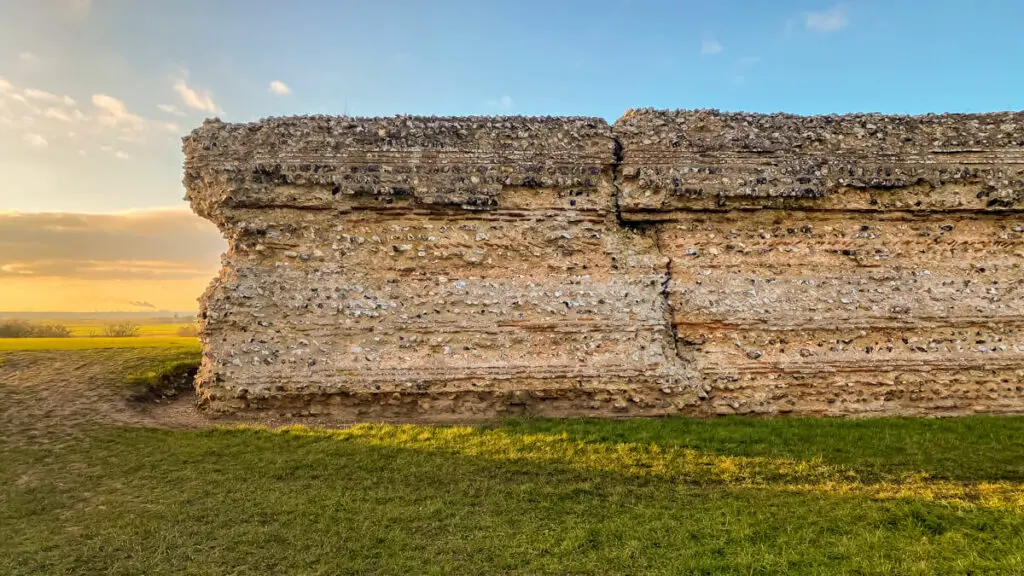
Burgh Castle has been the site of a Roman fort, Norman Castle, and possibly an early Christian monastery. It is the best preserved Roman monument in East Anglia and one of the most impressive Roman buildings in Britain. The ruins cover such a large area it is not possible to capture it all in one picture.
Most of what remains today is the ruins of the Roman fort that was built in the late 3rd century. Three of its four walls still stand. Long ago, the west wall fell into the marshes giving the fort the panoramic view across Breydon Water.
After the Norman Conquest, Burgh was used as a motte-and-bailey castle. The walls from the Roman fort enclosed the bailey, while the motte and a ditch were forged in the south-western corner. You can clearly see where the ditch has breached the south wall, but the mound has been flattened.
From the car park, you can do the one-mile circular walk which will take you to see the ruins and offers some scenic views over Halvergate Marshes and Breydon Water. Berney Arms Mill, the tallest drainage mill in the country, can also be seen in the distance. Read more in our guide to the Burgh Castle circular walk.
There is no admission fee to visit Burgh Castle and the site is open all reasonable daylight hours. It used to be free to park at Burgh Castle but they introduced a charge in June 2022.
If you want to see more Roman sites in Norfolk, check out our guides to Venta Icenorum and the Caister Roman Fort.
Get more information about visiting Burgh Castle here.
#6 Baconsthorpe Castle
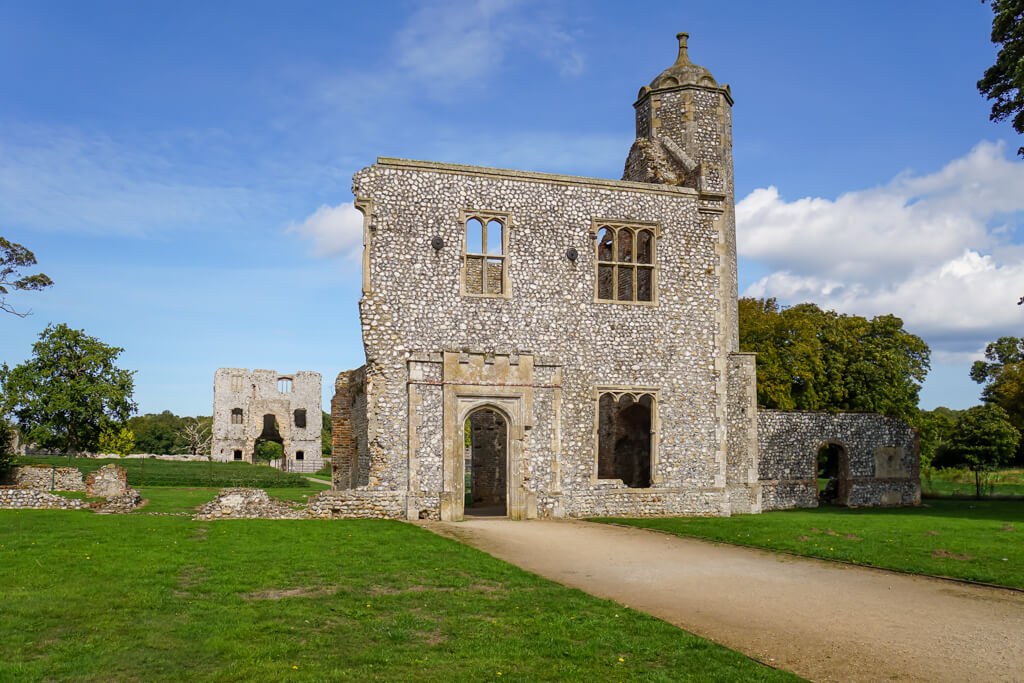
A few miles from the town of Holt, you will find the ruins of Baconsthorpe Castle, the moated and fortified 15th century manor house where the Heydon family once lived. Over 200 years, this ambitious family built, then enlarged, and finally abandoned this castle.
William Baxter, a free yeoman, acquired the site of Baconsthorpe from the Bacon family in the early 15th century. His son, Sir John, a lawyer, changed the family name to Heydon to disguise his comparatively humble origins and erected the inner gatehouse, which was the earliest castle building.
Sir John’s son Sir Henry completed the fortified house. Their descendants converted part of the property into a textile factory, which became their main source of wealth. They also added the turreted Elizabethan outer gateway, which was inhabited until 1920.
It’s free to visit and open any reasonable time during daylight hours. Pack a picnic as there are no facilities but plenty of space for kids to run around.
English Heritage looks after the property, so there is a small fee to use the car park if you are not a member. Learn more about English Heritage membership here.
Get more information about visiting Baconsthorpe Castle here.
#7 Thetford Castle
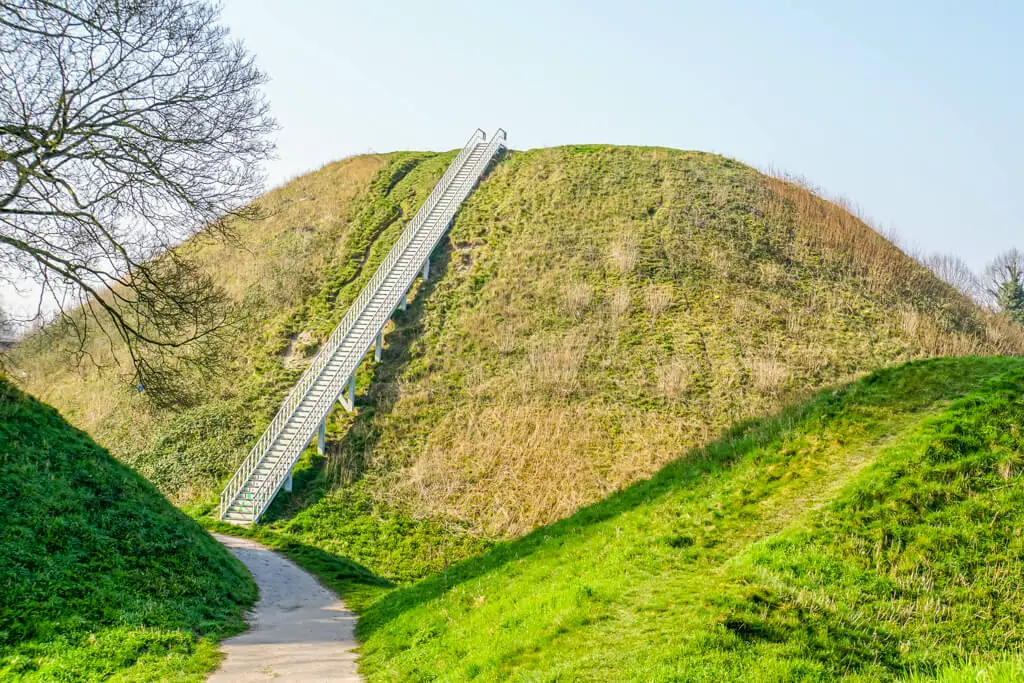
Most of Thetford Castle was destroyed by Henry II in 1173, but the huge motte, the second largest man-made mound in England, remains intact. It takes a bit of imagination to picture what Thetford Castle looked like in its prime as only the partial remains of a Norman motte and bailey fortification have survived.
The imposing mound was erected on top of an earlier Iron Age hillfort created around 500 BC and is surrounded by extensive earthwork defences, including twin ditches of considerable height and depth. Archaeologists found a bronze ‘terret” (a fitting for a horse’s harness) which they think may have been used on an Iceni battle chariot about 2000 years ago.
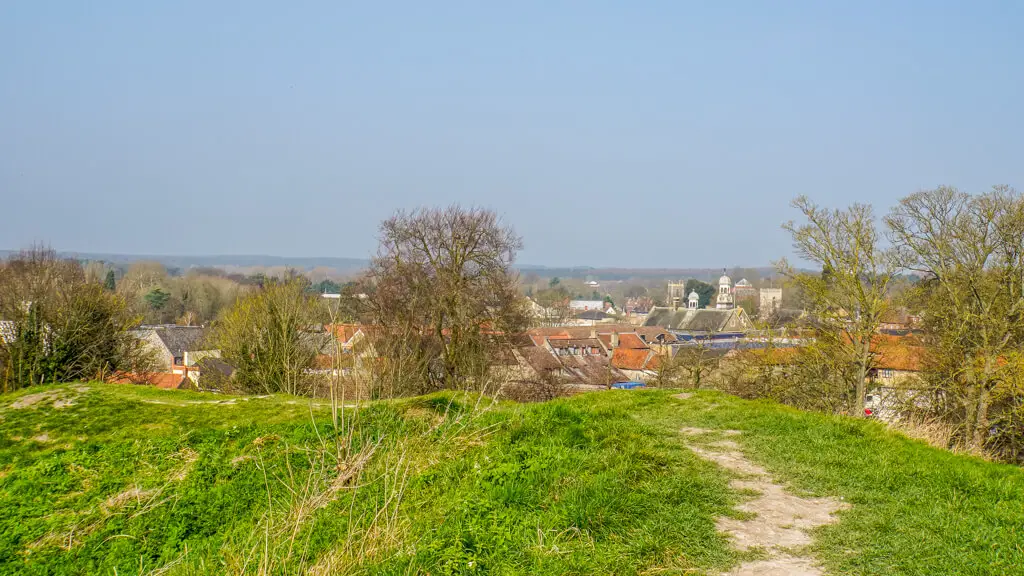
You can climb to the top of the Thetford Castle mound, thanks to a fibreglass staircase that the local council had installed in 2017, to enjoy views of the area. While some people may say the staircase is an ‘eyesore’ and ‘archaeological sacrilege,’ it will protect the motte from erosion.
It is free to visit Thetford Castle, which is now part of a park in the Thetford town centre. Also read about more things to do in Thetford.
Get more information about visiting Thetford Castle here.
Disclosure: This post contains affiliate links. This means we will receive a small commission for some purchases made using links in our blog with no additional cost to you. Please be assured we would not promote any product unless we believe that our readers will also benefit. The commission does not influence the editorial content of this site.

